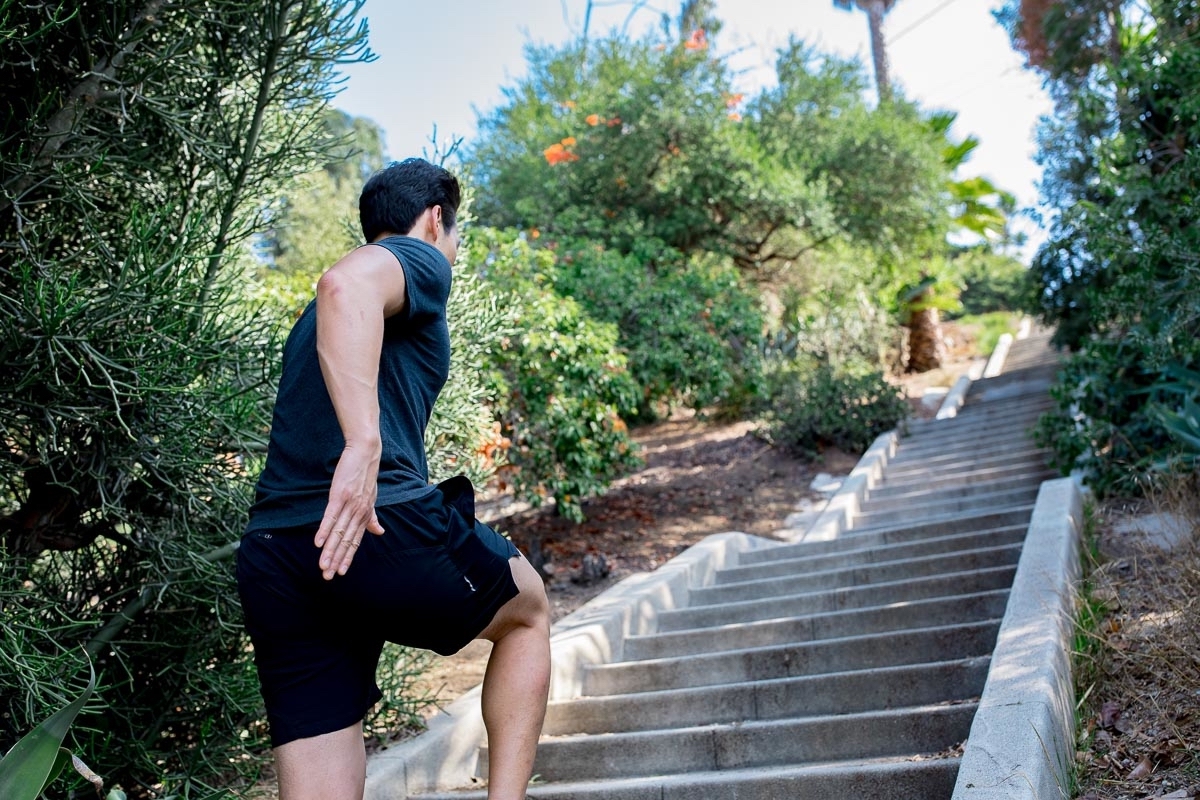The Secret Trick for Walking to Get Lean, Says Study

If you're a regular reader of ETNT Mind+Body, you're well aware of the fact that we're passionate proponents of walking for exercise—especially for those who are either new to fitness, fighting the effects of aging, suffering from poor sleep or any sort of mental illness, or those who are looking to bolster their existing routines with more activity. Even if you're ultra-fit, our resident fitness buff Tim Liu, C.S.C.S., says walking more every day can do wonders for your recovery process and ensure that you're maximizing your calorie burn all day long.
But if there's one thing that routinely annoys us, it's the enduring myth that you need to aspire to walk 10,000 steps every single day in order to be a healthy individual and get lean. On multiple occasions, we've explained why that number is entirely arbitrary, carved from thin air by marketing gurus, not exercise scientists. Put simply: No, you don't need to hit 10,000 steps every single day to get lean. Also, newsflash: You likely won't hit 10,000 steps every day even if you tried. After all, as a new article just published in The New York Times notes, studies have shown that remarkably few people can consistently reach 10,000 steps every day for a meaningful period of time.
So what should your goal be when you're going out walking? Well, if your ultimate objective is to get lean and burn as much fat as possible, one study has indicated that there's a better way to go. Read on to learn what it is, and if you love to walk for exercise, make sure you're aware of The Secret Cult Walking Shoe That Walkers Everywhere Are Totally Obsessed With.
Walking for Distance Vs. Walking for Time

If you're walking for exercise, chances are you usually head out after telling yourself one of two things: "I'm going out for a 4-mile walk," or "I'm going out for a one-hour walk." If you're walking at a brisk pace (roughly 4mph), the distance you'll cover is theoretically the same. But which is the better way to go if you want to maximize your workout? According to a study previously published in International Journal of Exercise Science, there's a clear answer.
The researchers set out to "compare walking/running for distance to walking/running for time as part of an exercise intervention" for weight loss. They recruited 15 overweight volunteers and divided them into two groups. One had to walk for a certain amount of time, the other a certain distance. (And for more great walking tips, see here for the Secret Tricks for Walking Your Way to a Flatter Stomach, Say Experts.)
Here's What They Discovered

By the end of the ten-week study, the walkers and runners who went out with a distance-oriented goal ended up losing an average of nearly 9 pounds. Those who walked or ran to a time-based goal? They actually gained an average of 2.4 pounds. Those who walked to distance had better blood cholesterol and glucose levels, as well. "The results of this study suggest that a distance-based exercise prescription of walking or running should provide a clinician or researcher with a closer estimation of overall [energy expenditure] and resultant weight loss and reduction of particular risk factors for [cardiovascular disease]," concludes the study.
The researchers speculated that the exercisers' mindset played a key role in the results. Those who walked to time didn't necessarily exercise as hard, they tended to overestimate their calorie burn, and they tended to overeat after their exercise sessions.
However, There Are Merits of Walking to Time

This isn't to say that there aren't merits to walking (or running) to time, of course. If your goal isn't necessarily maximizing your fat burn for a lean body, walking to time can help you walk farther, get in more steps, and may have great mental health benefits by making your walk more mindful and meditative, say experts. "On a physical level, it's good to focus on what elites sometimes call 'time on feet:' the idea that it's the clock, not simply the distance or pace, that informs our running and the impact it has on the body and the mind," the Nike running coach and Instagram influencer Knox Robinson once explained.
If your goal is simply better health—and even prolonging your life—you could benefit from walking to time. Let's say you decide to head out on a "3-mile walk," which may sound substantial. If you're going at a brisk pace—and you should be—you'll be moving at roughly 4 miles-per-hour. If you're fitter, a fast walk may be more like 5 miles per hour. At a brisk pace, you'll complete three miles in 45 minutes. At a fast pace, you'll get there in 36 minutes.
If you simply readjusted your mindset before going out, you'll find that you actually walked farther by one to two miles, went for a longer period of time, and got in more steps overall. Put simply: You need to figure out what works for you. For more amazing benefits of walking, see why Walking This Way Can Add 20 Years to Your Life, Says Top Scientist.
Need a Great Walking Workout?

If you'd really like to ramp up your fat burn, don't miss These Amazing Walking Workouts That Will Help You Get Lean, Says Top Trainer.







